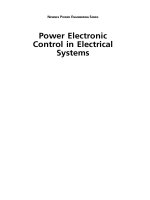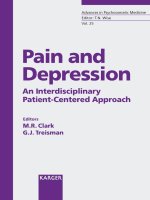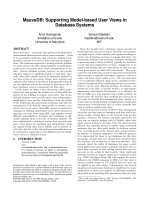ADVANCES IN EXPERT SYSTEMS pptx
Bạn đang xem bản rút gọn của tài liệu. Xem và tải ngay bản đầy đủ của tài liệu tại đây (9.58 MB, 128 trang )
ADVANCES IN EXPERT
SYSTEMS
Edited by Petrică Vizureanu
Advances in Expert Systems
/>Edited by Petrică Vizureanu
Contributors
Ivan Nunes Da Silva, Jose Luis Calvo-Rolle, Hector Quintian-Pardo, Sandra Rodrigues Sarro Boarati, Cecilia Sosa Arias
Peixoto, João Inácio Da Silva Filho, Ledisi Giok Kabari
Published by InTech
Janeza Trdine 9, 51000 Rijeka, Croatia
Copyright © 2012 InTech
All chapters are Open Access distributed under the Creative Commons Attribution 3.0 license, which allows users to
download, copy and build upon published articles even for commercial purposes, as long as the author and publisher
are properly credited, which ensures maximum dissemination and a wider impact of our publications. After this work
has been published by InTech, authors have the right to republish it, in whole or part, in any publication of which they
are the author, and to make other personal use of the work. Any republication, referencing or personal use of the
work must explicitly identify the original source.
Notice
Statements and opinions expressed in the chapters are these of the individual contributors and not necessarily those
of the editors or publisher. No responsibility is accepted for the accuracy of information contained in the published
chapters. The publisher assumes no responsibility for any damage or injury to persons or property arising out of the
use of any materials, instructions, methods or ideas contained in the book.
Publishing Process Manager Iva Lipovic
Technical Editor InTech DTP team
Cover InTech Design team
First published December, 2012
Printed in Croatia
A free online edition of this book is available at www.intechopen.com
Additional hard copies can be obtained from
Advances in Expert Systems, Edited by Petrică Vizureanu
p. cm.
ISBN 978-953-51-0888-7
free online editions of InTech
Books and Journals can be found at
www.intechopen.com
Contents
Preface VII
Section 1 Industrial Applications 1
Chapter 1 Intelligent Systems for the Detection of Internal Faults in
Power Transmission Transformers 3
Ivan N. da Silva, Carlos G. Gonzales, Rogério A. Flauzino, Paulo G. da
Silva Junior, Ricardo A. S. Fernandes, Erasmo S. Neto, Danilo H.
Spatti and José A. C. Ulson
Chapter 2 Electric Power System Operation Decision Support by Expert
System Built with Paraconsistent Annotated Logic 29
João Inácio Da Silva Filho, Alexandre Shozo Onuki, Luís Fernando
Pompeo Ferrara, Maurício Conceição Mário, José de Melo Camargo,
Dorotéa Vilanova Garcia, Marcos Rosa dos Santos and Alexandre
Rocco
Section 2 Research Applications 61
Chapter 3 Neural Networks and Decision Trees For Eye Diseases
Diagnosis 63
L. G. Kabari and E. O. Nwachukwu
Chapter 4 Heuristics for User Interface Design in the Context of Cognitive
Styles of Learning and Attention Deficit Disorder 85
Sandra Rodrigues Sarro Boarati, Cecilia Sosa Arias Peixoto and
Cleberson Eugenio Forte
Chapter 5 Neuro-Knowledge Model Based on a PID Controller to
Automatic Steering of Ships 101
José Luis Calvo Rolle and Héctor Quintián Pardo
Preface
In the area of control engineering, it is necessary to work in a continued form in obtaining
new methods of regulation to remedy the problem that already exists or to find better alter‐
natives to which they were used previously.
The economic agents now realize knowledge as an active relavant for the market organiza‐
tion differentiation. This scenario explains the need for systems that assist the user in the ac‐
quisition process and knowledge management. Intelligent systems, known as expert sys‐
tems, serve to this purpose in the extent that they have signed as facilitators in this process.
These are systems that are based on expert knowledge, on any subject, in order to emulate
human expertise in the specific field. To obtain this knowledge, the knowledge engineers,
also called software engineers, need to develop methodologies for intelligent systems. In
this area there is still no unified methodology that provides effective methods, notations and
tools to aid in development. The use of the recommendations helps the designer to interface
with more knowledge giving the possibility to access them in an automated fashion and
with various features, resulting in better recommendations and with best models specified
by users.
In developing of nonlinear expert system simulation models, the proper selection of input
variables is a challenging problem. Therefore, a false combination of input variables could
prevent the simulation model from achieving the optimal solution. The presented methodol‐
ogy in this book is an applicable approach for input variable selection in multi-input simula‐
tors of expert systems.
This book has 5 chapters and explains that the expert systems are products of the artificial
intelligence, branch of computer science that seeks to develop intelligent programs for hu‐
man, materials and automation.
Professor Eng. Petrică Vizureanu, Ph.D.
Director of the Department of Technologies and Equipment for Materials Processing
Faculty of Materials Science & Engineering
"Gheorghe Asachi" Technical University of Iasi
Romania
Section 1
Industrial Applications
Chapter 1
Intelligent Systems for the Detection of Internal Faults
in Power Transmission Transformers
Ivan N. da Silva, Carlos G. Gonzales,
Rogério A. Flauzino, Paulo G. da Silva Junior,
Ricardo A. S. Fernandes, Erasmo S. Neto,
Danilo H. Spatti and José A. C. Ulson
Additional information is available at the end of the chapter
/>1. Introduction
This chapter presents an approach based on expert systems, which is intended to identify
and to locate internal faults in power transformers, as well as to provide an accurate diag‐
nosis (predictive, preventive and corrective), so that proper maintenance can be per‐
formed. In fact, the main difficulty in using conventional methods, based on analysis of
acoustic emissions or dissolved gases, lies in how to relate the measured variables when
there is an internal fault in a transformer. This kind of situation makes it difficult to de‐
sign optimized systems, because it prevents the efficient location and identification of pos‐
sible defects with sufficient rapidity. In addition, there are many cases where the equipment
must be turned off for such tests to be carried out. Thus, this chapter proposes an architec‐
ture for an intelligent expert system for efficient fault detection in power transformers us‐
ing different diagnosis tools, based on techniques of artificial neural networks and fuzzy
inference systems. Based on acoustic emission signals and the concentration of gases present
in insulating mineral oil and electrical measurements, intelligent expert systems are able to
provide, as a final result, the identification, characterization and location of any electrical
fault occurring in transformers.
With the changes occurring in the electricity sector, there is a special interest on the part of
power transmission companies in improving and defining strategies for the maintenance of
power transformers. However, when a fault occurs in a transformer, it is generally removed
from the system and sent to a maintenance sector to be repaired. With this in mind, some
© 2012 da Silva et al.; licensee InTech. This is an open access article distributed under the terms of the
Creative Commons Attribution License ( which permits
unrestricted use, distribution, and reproduction in any medium, provided the original work is properly cited.
feasibility studies have been conducted, aimed at supporting the electrical system in order to
maintain the supply of energy, reducing operation costs and maintenance. Among these
investigations, researches have been accomplished into the identification of internal faults in
power transformers. In this case, the analysis of dissolved gases [1]-[5] and/or of acoustic
emissions [6]-[10] can be highlighted. Within the context of economic viability, it is worth
noting the increasing difficulty of removing an operating power transformer and placing it
under maintenance. Thus, the above techniques, which evaluate parameters or quantities that
indicate the current state of the transformer, have emerged as a more attractive alternative.
Although some papers deal with the development of tools for monitoring sensors [3], very
few papers can be found on the efficient use of both sensor types (dissolved gases and
acoustic emissions) in the same study. This is probably due to the fact that the cost asso‐
ciated with the acquisition of these sensors is very high. Another factor that should be
highlighted is the growing use of intelligent tools for identifying and locating of inter‐
nal faults [1-2, 5, 7].
The increasing use of intelligent tools is due to the fact that conventional techniques are not
always able to achieve high accuracy rates of fault identification. In one of the most out‐
standing studies in the area [1], which makes a comparison between conventional and intel‐
ligent tools, the authors propose a method based on obtaining association rules that perform
the best analysis of dissolved gases and satisfactorily ensure reliable identification of fail‐
ures. The authors compared the proposed technique with other conventional methods (Rog‐
ers and Dornenburg) and intelligent techniques (Neural Networks, Support Vector
Machines and k-Nearest Neighbors). A total of 1193 samples from dissolved gas sensors
were acquired, which were divided into two sets of data in order to evaluate each technique
used, i.e., one for training (1016 samples) and the other for validation (177 samples). After all
training and validation processes had been conducted, the following accuracy rates were ob‐
tained: Artificial Neural Networks (62.43%), Support Vector Machines (82.10%), k-Nearest
Neighbors (65.85 %), Rogers (27.19%), Dornenburg (46.89%) and Association Rules (91.53%).
According to the results, it can be clearly seen that intelligent systems outperform conven‐
tional methods.
In addition to this paper, in [2], the authors make a more detailed analysis of gases. In this
analysis, a total of 10 kinds of fault were considered, namely: partial discharge, thermal fail‐
ures lower than 150°; thermal failures greater than 150° and lower than 200°; thermal fail‐
ures greater than 200° and lower than 300°; cable overheating; current in the tank or iron
core, overheating of contacts; low energy discharges, high energy discharges, continuous
sparkling (a luminous phenomenon that results in the breakdown of the dielectric by dis‐
charge through the insulating oil), and partial discharge in solid insulation. It is worth men‐
tioning that the method applied in this study was based on a fuzzy inference system, which
was tested under controlled fault conditions. Other tests were also realized in Hungarian
substation transmission transformers, where the method performed well against the uncon‐
trolled failure scenarios.
Advances in Expert Systems4
However, studies [1] and [2] present a gap with regard to internal fault diagnosis for pow‐
er transformers, because they only identify the type of failure and do not locate the parti‐
al discharges.
In order to provide a better fault diagnosis for power transformers, some studies have used
acoustic emissions to locate faults due to partial discharges. Among these investigations, in
[8], the authors propose a geometric analysis of the arrival times of acoustic emission signals
in order to properly locate the sources of partial discharges. In the proposed methodology,
they use both time measurements from sensors and pseudo-measurements, which provide
greater precision in the tracking system of partial discharges.
In the context of these studies, this chapter aims to determine the necessary procedures for
the development of a methodology based on information from sensors for both dissolved
gases and acoustic emissions. The purpose of this methodology is achieve satisfactory re‐
sults for identifying internal faults, and, in the case of faults due to partial discharges, to lo‐
cate them accurately to help in the process of decision-making related to the maintenance of
transmission transformers.
The tasks of identifying and locating internal faults in power transformers are extremely im‐
portant, since they have a very high aggregate cost for purchase and for maintenance. Dis‐
solved gas analysis and the analysis of partial discharges by means of acoustic emission
sensors are essential for maintaining the equipment, and can bring many benefits, such as
reducing the risk of unexpected failures, extending the useful life of a transformer, decreas‐
ing maintenance costs and reducing maintenance time (due to the precise location of the
failure). Furthermore, with the processing of these data by means of intelligent expert sys‐
tems, it becomes possible to provide answers to help in the decision-making process about
the power transformer analyzed.
2. Internal Faults in Transformers
The diagnosis of the status and operating conditions of transformers is of fundamental impor‐
tance in the reliable and economic operation of electric power systems. The aging and wear
and tear of transformers determine the end of their useful life; thus, the occurrence of faults
can affect the reliability or availability of the power transformer. Understanding the mecha‐
nisms of deterioration and having technically feasible and economically viable repair strat‐
egies enables us to correlate faults with the operating evolution of the equipment in service [11].
Many techniques have been proposed to ensure the integrity, reliability and functionality of
power transformers, all of which seek trinomial low cost, efficiency and rapid diagnosis.
Among several techniques available for detecting internal faults in power transformers,
acoustic emission analysis can be highlighted because it is not invasive, allowing analysis to
be conducted on the equipment during normal operation [12].
A power transformer can be affected by a variety of internal faults, such as partial discharge,
electrical arcs, sparks, corona effects, and overheating. Of these, Partial Discharge (PD) can
Intelligent Systems for the Detection of Internal Faults in Power Transmission Transformers
/>5
be highlighted, since it is directly related to the insulation conditions of a power transform‐
er, which in turn trigger the occurrence of more severe faults. PD in high voltage systems
occurs when the electric field and localized areas suffer significant changes which enable an
electric current to appear [6].
According to [13], PD can be grouped into 8 classes:
• Point to Point discharges in insulating oil: these PDs are related to insulation defects be‐
tween two adjacent turns in the winding of a transformer;
• Point to Point discharges in insulating oil with bubbles: this kind of fault is also caused by
PD between two adjacent winding turns, but the condition of insulation degradation al‐
lows the formation of gas bubbles;
• Point to Plan in insulating oil: defects in the winding insulation system can cause PD be‐
tween it and the grounded parts of the transformer tank;
• Surface Discharges between two electrodes: the most common kind of PD, occurring be‐
tween two electrodes insulated with oil-paper called triple point, where the electrode sur‐
face is in contact with dielectric solids and liquids;
• Surface Discharges between an electrode and a multipoint electrode: the PD relating to
these elements differ from the previous one with regard to the intensity distribution of the
electric field. Both are insulated with oil-paper;
• Multiple Discharges on the plan: multiple damaged points in the winding insulation may
cause PD between it and the grounded parts of the transformer tank;
• Multiple Discharges on the plan with gas bubbles: the PD in this case occurs at various
damaged points in the winding insulation and the grounded parts of the transformer
tank, but in the presence of gases dissolved in insulating oil;
• Discharges caused by particles: in this case, the insulating oil is contaminated with parti‐
cles of cellulose fiber formed by the degradation process of the oil-paper insulation sys‐
tem, due to the aging of the power transformer. Such particles are in constant motion in
the oil, causing PD;
3. Laboratory Aspects for Internal Fault Experiments in Power
Transformers
It is important to specify equipment, methods and parameters, which vary according to the
type of defect that is to be analyzed. In simple terms, the monitoring system can be better
understood through Figure 1.
Advances in Expert Systems6
Transformer
Electric signals
Acoustic signals
Dissolved gas
analysis
Data Acquisition
Final Diagnosis
Data Processing
Figure 1. Laboratorial setup diagram.
The structures highlighted (inside the black boxes) are those that present the greatest chal‐
lenges for configuration and parameterization, which are entirely dependent on the type of
tests to be accomplished.
The most complete and detailed tests are (given their wide coverage of internal faults) more
complex and expensive due to the various devices necessary used for the fault detection and
location process, because more sensors and also data acquisition hardware are necessary.
3.1. Electrical measurements
Electrical parameters are also necessary for a correct characterization of internal transformer
faults, especially when dealing with systems that require databases for normal operating
conditions and with situations when a system has to be restored following a disturbance.
This is the case of artificial neural networks, which require quantitative data for the learning
process. It is necessary to measure voltages and three-phase primary and secondary cur‐
rents, totaling 12 electrical parameters. The acquisition frequency in this case must not be
high, because the purpose is to investigate the most predominant harmonic components in
the electrical system.
3.2. Acoustic measurements
The acoustic signals are captured by acoustic emission sensors distributed evenly through‐
out the tank, which are externally connected to the power transformer. Such sensors have
several characteristics that require a correct specification:
Intelligent Systems for the Detection of Internal Faults in Power Transmission Transformers
/>7
• Number of sensors per transformer: The number of sensors needed to detect internal
faults in transformers varies according to the size of the equipment, amount of available
channels and the type of fault to be detected. For the fault location task, for example, it
takes a greater number of sensors, so that the entire volume of the transformer can be
monitored. Thus, a total of 16 to 20 sensors is normally used [14];
• Pre-amplification: This item is extremely important because only the amplified acoustic
signals are sent to the acquisition hardware, which removes extraneous noises;
• Operating frequency: This is strongly dependent on the type of fault to be monitored. Me‐
chanical faults are associated with frequencies ranging from 20 kHz to 50 kHz, while elec‐
trical ones vary between 70 kHz and 200 kHz;
• Resonance frequency: This parameter defines the frequency where the signal gain is maxi‐
mum. For maximum performance, it is necessary for the resonance frequency of the sen‐
sor to be tuned to the phenomenon to be monitored. The most common sensors have a
resonance frequency of 150 kHz.
The experimental apparatus for supporting experiments aimed at testing computer systems
developed for identifying and locating partial discharges in power transformers consists of a
metal tank, in which all the devices responsible for the acquisition of acoustic and electrical
signals are mounted. Figure 2 illustrates a tank specially prepared for this purpose.
Figure 2. Tank for experimental testing.
Figure 3 illustrates the attachment of an acoustic emission sensor mounted on the outside of
the metal tank, whose signals are transmitted via cable to the acquisition system.
Advances in Expert Systems8
Figure 3. Acoustic emission sensor fixed to the outside of the tank.
Figure 4 illustrates a device made in order to produce partial discharges in the tank. The
mechanism can also be moved within the tank, in all directions, by means of a rail and pul‐
ley system.
Figure 4. Device to produce partial discharges in the tank.
3.3. Measurements of dissolved gases
Measurement of dissolved gases in insulating oil can be acquired from chromatographic
analysis of the oil, which is often performed in the laboratory. However, there are now some
Intelligent Systems for the Detection of Internal Faults in Power Transmission Transformers
/>9
commercial devices that sense some gases dissolved in the oil. These devices can be used to
monitor a power transformer in real time. It is worth mentioning that, through the analysis
of dissolved gases, it is possible to obtain a first indication of a malfunction, which is usually
related to electrical discharges and overheating.
Figure 5 shows the installation (in the tank) of the gas sensor, which is responsible for ac‐
quiring information on the quantities of gases dissolved in the insulating oil in order to re‐
late them to internal defects.
Figure 5. Gas analysis sensor installed in the experimental tank.
3.4. Equipment for data acquisition
As seen above, the frequencies for electrical signals differ greatly from those found in acous‐
tic signals, whose acquisition hardware can be divided into two according to technical and
financial aspects:
• Hardware for electrical signals: for power quality purposes established in the Brazilian
standard PRODIST [15], the 25
th
harmonic is the last one of interest. Thus, according to
the Nyquist criterion, a minimal acquisition rate of 3 kHz is required. For electrical pa‐
rameters it is also possible to use hardware with an A/D multiplexed converter, which re‐
duces the cost of equipment;
• Hardware to acoustic signals: one of the factors that make this hardware expensive is the
need to use an A/D converter for each channel. The sources of acoustic emissions also
vary between 5 kHz and 500 kHz, where an acquisition frequency in MHz is necessary.
Advances in Expert Systems10
3.5. Computer for receiving and processing data
The computer is responsible for storing acoustic, electrical and dissolved gas data coming
from the hardware acquisition. The hardware bus speed and the disk storage capacity must
also take into account the amount of planned experiments, although a high performance
disk is unnecessary, since a SCSI bus can be used.
3.6. Analysis and diagnosis
The implementation of this structure is very challenging, because it consists of a combina‐
tion of techniques to efficiently identify and locate faults in power transformers. Among
these techniques, those based on intelligent systems have efficiently increased the perform‐
ance of processes involving the detection and location of faults [13].
4. Data Analysis from Acoustic Emission Signals
Altogether, we collected 72 oscillograph records of partial discharges. Each of these records
depicts a time window of one second. In general, many occurrences of partial discharge are
registered in these time slots.
In addition to this phenomenon, the data acquisition system also recorded mechanical
waves that were used to evaluate the gauging of acoustic emission sensors. These waves are
the result of the break, near the surface where the sensor is installed, of graphite with speci‐
fications given by the manufacturer of acoustic emission sensors. The graphs resulting from
this test are highlighted in Figure 6.
Figure 6. Acoustic emission signal resulting from the gauging process of sensors.
Intelligent Systems for the Detection of Internal Faults in Power Transmission Transformers
/>11
As shown in this figure, the signal is thus composed of two well-defined moments. The first
of these relates to the instant when there was a mechanical disruption of graphite, while the
second stage is the result of the impact of the pencil with the surface where the acoustic
emission sensor is installed.
Figure 7 shows in more detail the first moment of the mechanical wave in Figure 6, while
Figure 8 illustrates how the mechanical waves are related to the currents resulting from par‐
tial discharges.
Figure 7. Details of the acoustic emission signal resulting from the gauging process of sensors.
Figure 8. Relationship between partial discharge current and acoustic emission waves.
Advances in Expert Systems12
From Figure 8 we can see that each partial discharge results in a highly correlated mechani‐
cal wave. The graphs shown in Figure 9 highlight this relationship more clearly.
Figure 9. Detail of relationship between partial discharge current and acoustic emission.
Figure 10 illustrates the average frequency spectrum of an acoustic emission signal coming
from a standard partial discharge. Through this frequency behavior, it can be seen that there
is high signal energy at approximately 95 kHz and within the range between 160 kHz and
180 kHz. These values are of great importance in distinguishing partial discharge signals
from other interferences.
Figure 10. Average frequency spectrum of acoustic emission signal coming from a partial discharge.
Intelligent Systems for the Detection of Internal Faults in Power Transmission Transformers
/>13
In order to verify the behavior of the sensors for the tests, the voltage and current signals are
processed in order to find the frequency response of these devices. In Figure 11 the ampli‐
tude versus frequency for the first calibration test has been recorded. The top of the graph
highlights the energy and voltage signals sampled, and at the bottom there is the amplitude
versus frequency. From the signal analysis it is then possible to observe a maximum re‐
sponse around 400 Hz and 100 kHz.
Figure 11. Frequency response of the acoustic emission signal.
Figure 12. Detail of frequency response of the acoustic emission signal (segment 1).
Advances in Expert Systems14
In Figure 12, the signals were assigned in segments where the amplitude was more signifi‐
cant for detection purposes, which now represents the presence of different peak amplitudes
at various frequencies.
The energy signal shows an envelope having important information, making clear the dif‐
ferences between the acoustic emission signal and the reflections that are also registered. In
order to better evaluate these peaks, segments of interest were amplified and the frequency
response was recalculated for this section, as reported in Figure 13.
Figure 13. Detail of frequency response of the acoustic emission signal (segment 2).
In the segment highlighted in Figure 12, there is clearly a large concentration of low frequen‐
cies, with maximum amplitude at 10 Hz. In contrast, Figure 13 presents a large concentra‐
tion at 100 kHz and another at approximately 2.5 MHz.
It is worth noting that, in the light of the two analyses, the signal with higher energy, record‐
ed in the first segment, has an extremely low frequency wave. Thus, the propagation veloci‐
ty tends to be higher due to the proximity to the spectrum of mechanical waves. However,
for higher frequencies, typically observed in electromagnetic waves, there is a decrease of
the signal energy, because this wave will suffer large attenuation when propagating through
the insulating oil. Thus, the signal perceived by the acoustic emission sensor has already suf‐
fered severe degradation before being detected. This attenuation phenomenon is of great
importance for the location process of partial discharges when installing more sensors in the
experimental tank. In fact, since the speed of wave propagation in the insulating oil is
known, it is then possible to estimate the location of the source of discharge.
The energy calculation is performed to obtain the full power of a signal. However, some sig‐
nals are negative and therefore a quadratic sum of the sampled points must be calculated, as
shown in the following equation:
Intelligent Systems for the Detection of Internal Faults in Power Transmission Transformers
/>15
=
åå
2
,
=1 =1
sinal
NM
ij
ij
E
(1)
where N is the i-th window, and M represents the j-th point of the data window (consisting
of 1101 points per window).
Thus, it may be noted that each data window corresponds to an acoustic emission signal
measured by a given sensor. In this case, 8 sensors are used and, therefore, for each partial
discharge we have 8 data windows. In addition, 10 samples for each partial discharge are
still considered, which were obtained at different moments. Thus, the energy calculation for
each of the 8 acoustic emission sensors is shown form Figures 14 to 21. Moreover, three dif‐
ferent experiments were compared, where there was variation in the depth of the partial dis‐
charges in the oil tank used during the tests.
Experiment 1 represents a partial discharge located at 5 cm from the surface of the insulat‐
ing oil, while experiments 2 and 3 are respectively located at 21.5 and 40 cm from the surface
of the insulating oil.
Experiment 3 also had a small variation in the distance of the partial discharge from the
front of the experimental tank, where it was moved 1 cm with respect to the original posi‐
tion of tests 1 and 2.
It is important to mention that this displacement is made in such away that the partial dis‐
charge of experiment 3 could be detected by sensors closer to the front wall of the tank,
where it was expected that sensors 1 and 2 allocated on the wall would be more sensitive in
experiment 3 rather than in experiments 1 and 2.
From Figures 14 and 15 it is possible to observe the energy response supplied by sensors 1
and 2 (for each of 10 samples), which represents the greatest contribution of experiment 1 in
sensitizing them, while sensor 3 shows an energy response which makes it difficult to define
which experiment caused the highest sensitization (Figure 16).
Figure 14. Energy response calculated for sensor 1 (mounted on the front wall - bottom right) during experiments 1, 2
and 3.
Advances in Expert Systems16
Figure 15. Energy response calculated for sensor 2 (mounted on the front wall - top left) during experiments 1, 2 and 3.
Figure 16. Energy response calculated for sensor 3 (mounted on the side wall-lower right corner) for experiments 1,2 and 3
The sensor 4 showed an energy response similar to that already shown for sensors 1 and 2
(Figure 17).
Figure 17. Calculated energy response for sensor 4 (mounted on the side wall - upper left) during experiments 1, 2 and 3
Intelligent Systems for the Detection of Internal Faults in Power Transmission Transformers
/>17









